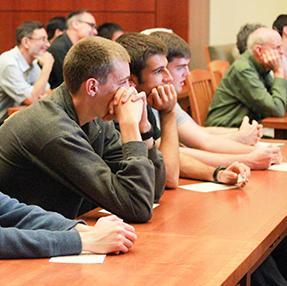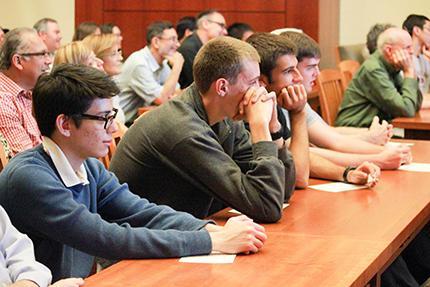
The Varieties of Goodness
A Response to Terry Eagleton
“If atheist and theologian can agree on one proposition at least, it’s surely there’s no point to God whatsoever. What is he good for? Nothing. If we can speak of him as good, which is questionable, he’s good for nothing. He’s good for no reason, benefit, gain, practical advantage, instrumental end, simply good for entirely, purely entirely for its own sake. Or to adopt a more technical theological term, good just for the hell of it.”– TERRY EAGLETON1
Terry Eagleton, hoping to remind atheists of the deeper theological context of the God-debate, audaciously asserts that God is good for nothing. Theologically, I agree with him. But on a more concrete, human level, I would also argue that God is good for everything.
Eagleton wants to remind atheists that the theist view of God is not merely a concept to underpin morality or explain scientific unknowns. The goodness of God, Eagleton insists, lies in His autotelic nature: God is Her own end-in-Herself. Personally, I too struggle when I see God used as an idol to be sacrificed at the altar of a political or psychological need, or a “Get out of Hell Free” card in soteriological Monopoly. But to look at the question of “What good is God?” we must take into account the ways individuals and cultures use God, whether we find those uses palatable or not. While God is not merely an instrumental good, God (and what we believe about God) is quite meaningful, and meaningful for everything.
In his talk, Eagleton mentioned that Abraham did not ponder the existence of God. For Abraham and others across time and space, the deeper question is not “Does God exist?” but “Does God care?”2 The world’s treasury of great religious literature testifies to our grappling with the care of God or gods, whether that care is expressed in covenant, cross, or abundant crop. The question of “What good is God?” must not only include the lofty theological discourse of Augustine and Aquinas but the lived human experience of individuals such as Abraham. The faith of the followers of Abraham holds that a divine reality (often called God) holds the metaphysical and moral order together. Eagleton compares God to modern art: Both are useless, ends in themselves, creation for the joy of creation rather than a social function. He contrasts this to ancient art. The tales of Odysseus and Beowulf are not just entertaining stories but epics enshrining a heroic ethos for their Greek and Anglo-Saxon cultures. That mythological function is why I always place my feet first toward the ancient and medieval displays at art museums as this art, to me, seems to be good for something.
In the same way, my studies in comparative religion and interfaith work have taught me that the meaning we humans crave is always good for something. As sociologist Peter Berger phrases it, we seek to live under a “sacred canopy” that provides order to individuals and societies.3 God is just one common tent-pillar of a sacred canopy. These sacred canopies, providing systems of moral and metaphysical meaning, are good for everything. As those of us in the comparative religion guild know, this meaning is both a promise and a peril.
Although I grew up in a nonreligious home and only came to my own Christian faith as an adult, I have been fascinated by the
My studies in comparative religion and interfaith work have taught me that the meaning we humans crave is always good for something.
worlds of religious meaning that people create since childhood. At fourteen I attended a local megachurch performance titled “Heaven’s Gates and Hell’s Flames,” featuring people in their last moments before death. They would be led up to the pearly gates, where St. Peter would look for their names in his gilded book. The elect would be let through the gates, and the rest would be dragged down to hell—the back of the church— by Satan and his screaming minions. Predictably, the performance ended with an altar call. Frightening as it was to me, I could see that for most of the audience the evening was consoling. They could leave reassured of the ultimate justice of the universe and the righteousness of their worldview. Depending on your paradigm, this display either strengthened their faith or reinforced their sacred canopy.
This liturgical performance is also a perfect example of one peril of a sacred canopy. In this case, the blessed heaven-dwellers must be balanced out with those not so lucky. I would postulate that deep in every religious tradition are central beliefs, theological fulcrum-points, which contain uncharitable or just plain inaccurate statements about religious others. “Heaven’s Gates and Hell’s Flames” certainly gave me the impression that every non-Christian is a moral failure. Even the textual heart of Christianity, the meditative and moving New Testament, contains some of this polemic.4 As the Jews in Matthew exclaim, “His blood be on us and on our children!”5 Similar studies in the texts and histories of Buddhism and Islam make me suspect that every religion has a stock of stereotypes used to paint religious others. Nineteenth-century Sri Lankan Buddhist apologists used centuries-old anti-Hindu apologetics against the possibility of God to refute British Christian missionaries.6 Some Muslims, citing the Qur’an, associate Christians with polytheists for their belief in the Trinity.7 These unfair depictions of religious others are one major peril of a sacred canopy.

Despite these perils, our sacred canopies structure our lives, whether for good or bad. Not only is God’s being good for everything key in the history of religions, it is what drives interreligious dialogue. I currently work as the Interfaith Ministries Intern in Santa Clara University’s Campus Ministry Department. I believe mywork is premised on the fact that the beliefs we hold about God, gods, or no-gods are good for everything. For example, in a recent discussion with a young-earth creationist, I realized that his belief about God was part of a web of other beliefs about science, human reason, and scriptural inerrancy. While he did not convert me to his view, my stymied experience forced me to re-examine my sacred canopy and the portrait I had painted of him. It forced me to re-examine what science and the Bible mean to me. If our ideas about God or Ultimate Reality were only good for nothing, if they had no impact on our lives, we would have no need to talk about them. We would experience neither awakening nor frustration in those difficult dialogues.
Like Eagleton’s Jesus, this kind of interreligious encounter is not solely some fuzzy opiate of friendliness, but a challenge. In our pluralistic culture, it is also a necessity, as some in the atheist-humanist movement are recognizing.8 While it is true that God is good for nothing theologically, God (or whatever we believe about Ultimate Reality) is good for everything within so many dimensions of our human lives. Only when we understand this can we have a broader conversation about what kind of good God may or may not be.
Jonathan Homrighausenhas never met a religion he didn’t like. A Christian tinged with Buddhism and paganism, he transferred to Santa Clara University after studying philosophy at Modesto Junior College. A religious studies major, he serves as Interfaith Ministries Intern in Santa Clara University’s Campus Ministry Department. In his other life, he is a classics major fascinated by all ancient languages and mythologies, on which he blogs regularly at jdhomie.com. After graduating he hopes to pursue a Ph.D. in religious studies or theology in the hopes of furthering interreligious dialogue.
Endnotes
- Terry Eagleton, “Why Is God for Christians Good for Nothing?,” lecture, 2013-2014 Bannan Institute: What Good Is God? series, October 7, 2013, Santa Clara University. A video of the full lecture is available online at: http://scu.edu/ic/ publications/videos.cfm
- For this particular phrasing I am indebted to David Pinault, professor of religious studies at Santa Clara University.
- Peter Berger, The Sacred Canopy: Elements of a Sociological Theory of Religion (New York: Anchor Books, 1969).
- For example, see Amy-Jill Levine, The Misunderstood Jew: The Church and the Scandal of the Jewish Jesus (New York: HarperOne, 2006).
- Matthew 27:25, NRSV.
- R.F. Young and G.P.V. Somaratna, Vain Debates: The Buddhist- Christian Controversies of Nineteenth-Century Ceylon (Vienna: De Nobili Research Library, 1996).
- See, for example, Qur’an 4.171, 5.73, 5.116; this theme continues in contemporary pro-Muslim apologetics, such as Muzaffar Haleem (ed.), The Sun is Rising in the West: New Muslims Tell About Their Journey to Islam (Beltsville, MD: Amana Publications, 1999).
- See Chris Stedman, Faitheist: How an Atheist Found Common Ground with the Religious (Boston: Beacon Press, 2012).